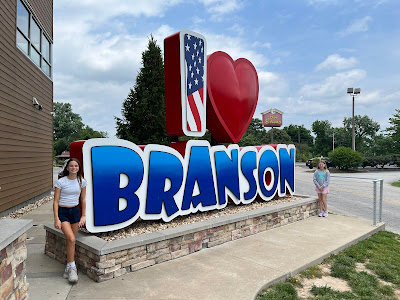Randy and I had visited Branson during Christmas time 2023. We thought it might be a fun place to take Kinley and Brooke. It was a relatively short drive from Topeka to Branson, giving us more time to actually enjoy the activities. We wanted to do it before the full heat of the Ozark heat and humidity hit, so we went the first week of June. I had cataract removal and a glaucoma stent surgery in one eye May 19, and my eyesight is less than ideal at the moment. But we still had a great time, and I hope we created some memories for the girls. Both Jill and Eric remember grandparent trips they took as kids.
We didn't do a lot of repeat activities. But there was one I wanted to do for sure. I thought The Butterfly Palace would be a fun place for Kinley and I to accomplish some 4-H photography. And I had loved it on our first visit. In a simulated rainforest, there were more than 1,000 live exotic butterflies imported from their native countries.
 |
| Photo by Kinley |
We thought there were even more butterflies to view on this trip, compared to the first time we visited.
Besides visiting the rain forest, we watched the 3-D Flight of the Butterflies movie to learn more about the Monarch Migration.
The girls were bigger fans of the Mirror Maze than grandma and grandpa were. But we all loved the colorful butterflies.
The girls and Randy even got to release some butterflies into the enclosure.
Even though they were firmly strapped in, it may have created a little "Grandma anxiety." But they loved it. Grandpa predicted he'd be sore the next day. He was.
 |
| Photo of the outside of the building from the internet |
WonderWorks is a science focused indoor amusement park that combines education and entertainment.
It has more than 100 hands-on exhibits with varying degrees of skill and danger.
We made music.
They "rode" snow boards.
They rode the Wonder Coaster.
My heart might have been in my throat when I watched them on this ride that went all the way around - just from their furious pedaling.
My anxiety level could again decrease as they made life–sized bubbles.
They got some simulated NASA training in the Astronaut Training Gyro.
The museum also promoted exercising your mind. Grandma is all for that!
The next day was a roller coaster kind of day for Randy and the girls at Silver Dollar City. But first, they had to get their bearings. Randy has always been a map lover. In fact, it's kind of a family inside joke. Maybe it's genetic?Their favorite roller coaster was the Time Traveler, but they rode all the coasters multiple times.
 |
| They thought Fire in the Hole was a little tame, but they loved Wildfire. |
At first, Kinley wasn't interested in getting on the giant swing. But they all ended up riding it multiple times because there wasn't a line.
My only ride was the train. However, I was a champion holder of all things. That is a good commodity for roller coaster riders. Thankfully, there were plenty of shaded seats outside those venues.
That night, we went to the Dolly Parton Stampede.
We had told the girls that they'd have to eat with their hands. But unlike our visit in December 2023, we got a fork this time. That was handy for the mashed potatoes, among others things. The server joked with Kinley and gave her one Cornish hen wing to begin with. He had actually run out of meat in a tray. When he came back, he asked if she was still hungry. He gave her another wing. But then she got the whole Cornish hen. She was a good sport about it!They put on a spectacular show. We didn't know if the girls would think it was hokey, but they really seemed to like it.The theme this summer was butterflies, and it was beautiful.But there was plenty of Old West imagery, too, along with horseback acrobats. We were sitting near one of the entrances for the performers, and the girls seemed to really enjoy watching the logistics of the show.
Before we left for home, Randy wanted to share a little magic with the girls. He'd purchased a card trick for each of them at the magic shop at Silver Dollar City. They got a little magic lesson in the hotel room.
On the way home, we stopped by Kansas City to see Brent, Susan and their new puppy, Clover.
The girls had already met her, but it was Randy and my first introduction.Clover is a golden retriever. Besides taking the girls to a variety of Branson attractions, we also indoctrinated them on the fine music of the 1970s. We had them singing along by the end. It's always good to educate the next generation on the important things of life.
















































